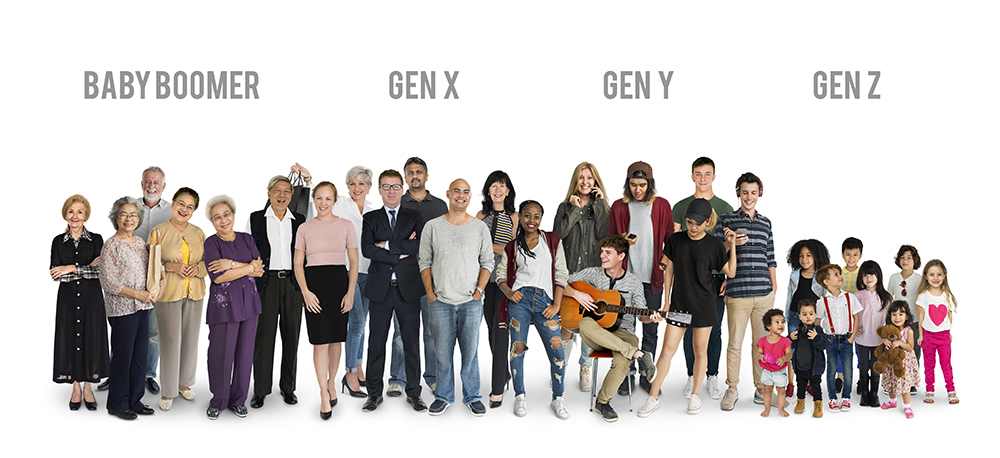In the ever-evolving world of fashion, each generation develops its own unique style identity, shaped by cultural influences, technological advancements, and societal values. From Baby Boomers to Gen Z, these distinct fashion preferences reflect not just changing trends, but also shifting attitudes and priorities. Let’s explore how fashion choices vary across generations and what drives these differences.
Baby Boomers: Classic Elegance with a Rebellious Past
Baby Boomers (born 1946-1964) experienced fashion as a form of cultural revolution. Their style journey began with the casual influences of Hollywood stars and rock n’ roll music, embracing poodle skirts, leather jackets, blue jeans, and saddle shoes as teens1. Women of this era moved away from constricting girdles toward more comfortable undergarments, while the iconic housewife style featured shirtwaist dresses, pearls, and perfectly styled hair1.
The 1960s and 70s marked an explosion of fashion creativity for Boomers, with the hippie movement inspiring bohemian trends like bell bottoms, tie-dye, peasant blouses, and fringe vests1. Jackie Kennedy epitomized early 60s refinement with prim skirt suits and pillbox hats, while the miniskirt became the defining look later in the decade1.
Today’s Baby Boomers tend to prefer quality, comfort, and classic styles5. They value durability and authenticity in their fashion choices7. Despite their cautious approach to new technologies, they remain digitally connected, often preferring desktop computers over mobile devices for online shopping6.
Generation X: Practical Individualists
Generation X (born 1965-1980) embraced individual expression over conformity in their fashion choices1. The 1980s saw Gen X adopt power dressing for career advancement, with women donning masculine-inspired looks like tailored suits with padded shoulders1. Menswear took a flamboyant turn with designer logos, pastels, bomber jackets, and jogging suits defining the decade1.
The 1990s brought a shift toward minimalism and grunge, with flannel shirts, Dr. Martens boots, oversized silhouettes, and androgynous styles reflecting Gen X’s disaffected attitudes1. The punk movement’s influence brought leather, spikes, ripped tights, and tartan as a rejection of disco decadence1.
Today, Gen X takes a balanced, pragmatic approach to fashion. They prioritize understanding the impact and value of their clothing choices3. This generation appreciates straightforward, no-nonsense communication from fashion brands and tends to focus on practical applications rather than novelty4.
Millennials: Nostalgic Innovators
Millennials (born 1981-1996) came of age in a digital world filled with choices and self-expression1. Their fashion sensibilities are driven by comfort and practicality, with a focus on versatility in their wardrobes10. They seek pieces that can transition seamlessly from day to night and value personal expression through a mix of vintage, second-hand, and modern trends10.
In 2025, Millennials’ fashion preferences continue to shape industry trends, blending nostalgia with modernity and sustainability3. Their wardrobes feature 90s and Y2K-inspired styles, including crop tops crafted from premium materials, oversized denim pants, and colorful chunky sneakers from brands like New Balance or Fila3.
Brand loyalty is a notable aspect of Millennial fashion, with strong connections to brands that align with their values and provide a sense of authenticity10. They’re the driving force behind promoting brands but paradoxically don’t trust traditional advertising, preferring influencer marketing and authentic content4.
Generation Z: Digital Natives with Purpose
Generation Z (born 1997-2012) is spearheading uniquely modern fashion aesthetics1. As digital natives, their fashion identity revolves around internet subcultures, from e-girl and e-boy looks to VSCO girls and cottagecore1. Social media apps like TikTok and Instagram fuel the rapid rise and fall of micro-trends personalized to each user1.
Gen Z values individuality, self-expression, and authenticity in their fashion choices10. They emphasize uniqueness and personal style, gravitating toward sustainable and ethical fashion from brands that align with their values10. This generation has inverted the traditional design process—aesthetics like Barbiecore, Cottagecore, Dark Academia, and Coastal Grandma originated bottom-up from social media rather than top-down from fashion brands11.
Gen Z is more self-consciously stylish than Millennials, with 49.1% saying they’re “more fashionable than most people” compared to 42.3% of Millennials13. They’re also more attuned to social responsibility, with 60.2% believing fashion brands should address social issues (versus 53.8% of Millennials)13.
Key Differences in Fashion Choices
When comparing generations directly, several distinct patterns emerge:
Style Approach
- Baby Boomers: Prefer classic, timeless pieces with quality construction
- Gen X: Embrace practical, versatile fashion with individual touches
- Millennials: Blend comfort with personal expression and brand alignment
- Gen Z: Prioritize individuality, self-expression, and rapid trend adoption
Color and Pattern Preferences
Baby Boomers and Generation Y (Millennials) show different color preferences. For example, Baby Boomers preferred orange-colored apparel more than Generation Y, and there was a significant difference in the two groups’ preferences for the color orange7. Generation Y considers brown apparel to be outdated and out of style7.
Shopping Behavior
While Millennials and Gen Z share some shopping priorities (price, value, quality, and fit), Gen Z shows greater concern with style and social issues13. Design (32.7% vs. 27.9%) and fashionableness (23.3% vs. 21.2%) are the most distinctively Gen Z purchase factors, followed by sustainability and production practices13.
Millennials, by contrast, are more concerned with fabrics and materials (11.0% vs. 8.0%) as well as with the functionality of their garments (21.4% vs. 17.7%)13.
Fashion Brand Loyalty Across Generations
Each generation gravitates toward different fashion brands that align with their values and aesthetic preferences:
Gen Z’s Most Loyal Brands:
- American Eagle Outfitters
- Hollister (22 times more likely to follow on social media compared to general public)
- Nike
- H&M
- Gucci12
In 2025, Gen Z is shopping from brands like Turn Black (known for undefinable silhouettes that break away from gender and size categorization), The Souled Store (pop culture-inspired collections), O’Frida (breathable fabrics in earthy tones), and SIX5SIX Street (sports and streetwear focused on self-expression)9.
Millennial Favorites:
Millennials show loyalty to brands that offer both comfort and style, with sustainable practices becoming increasingly important3. They respond well to brands that offer nostalgic elements while incorporating modern sustainability practices.
The Future of Generational Fashion
As we look ahead, several trends are emerging in how generations approach fashion:
- Sustainability across generations: While Gen Z leads in demanding sustainable practices, all generations are becoming more conscious of environmental impact.
- Gender-fluid fashion: Particularly among younger generations, gender-neutral clothing is gaining popularity, with oversized fashion becoming a top trend3.
- Cross-generational influence: The traditional parent-child fashion influence is evolving, with mothers and daughters often sharing fashion advice throughout adulthood7.
- Vintage appreciation with generational twists: While passing down clothes has always been a tradition, each generation approaches vintage differently. Baby Boomers value vintage for authenticity, quality, and durability, while Gen Z places importance on image—consuming vintage products to enhance their style and individuality7.
Fashion continues to be an influential form of communication and expression across all age groups. By understanding these generational differences, brands can better connect with diverse consumers, and individuals can appreciate the rich tapestry of influences that shape our collective style landscape.

